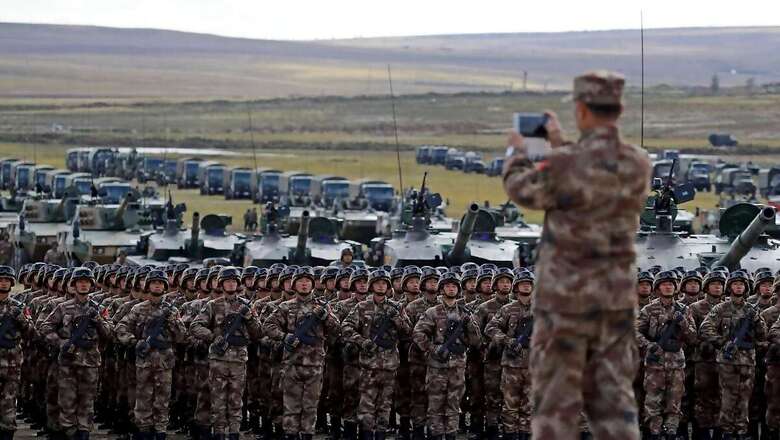China Rebuilding Nuclear Test Facility? Latest Satellite Images Show Activity at Remote Lop Nur Base

views
In what could be a high-impact development on regional security, China is quietly rebuilding its Lop Nur base for nuclear testing in the remote Xinjiang Uygur Autonomous Region. Satellite images first published by The New York Times indicate that India’s secretive neighbour is looking to reactivate the facility, where it will be able to conduct full-fledged nuclear weapons testing or subcritical nuclear explosions.
By definition, subcritical, or cold, tests simulate aspects of nuclear explosions by using chemical explosives. They involve nuclear materials and possibly high explosives, which purposely result in no yield. China, however, has categorically dismissed the NYT report saying it was “clutching at shadows, groundlessly whipping up a ‘China nuclear threat'”.
The NYT report is based on evidence provided by Dr Renny Babiarz, a leading international expert on geospatial intelligence. A former Pentagon analyst, he spent years studying satellite imagery of the Lop Nur facility where China conducted its first nuclear tests on October 16, 1964.
This is not the first time such reports have surfaced. In April 2020 as well, a US State Department report had stated that China may have conducted secret low-level underground nuclear test explosions. Back then, the country had said it is committed to a moratorium on nuclear tests and actively fulfilling commitments to treaties on arms control. Its foreign ministry had said the false accusations by the US are not worth refuting.
In its report, the State Department had said China may have secretly set off low-level underground nuclear test explosions despite claiming to observe an international pact banning such blasts. Washington’s concerns about Beijing’s possible breaches of a “zero yield” standard for test blasts have been prompted by activities at China’s Lop Nur nuclear test site throughout 2019, the report added.
The satellite images of Lop Nur by Maxar Technologies over the last few years show a process of upgrading the facility. “By 2017, an old site with a handful of buildings had turned into a slick, ultramodern complex ringed by security fences,” stated the NYT report. “Its new structures included a bunker protected by earthen berms and lightning arresters, making it ideal for handling high explosives.”
According to a report by the Middlebury Institute of International Studies at Monterey, a little more than a decade ago, China possessed at least 50 intercontinental ballistic missiles. “The People’s Liberation Army Rocket Force is now on track to deploy more than 1.000 ballistic missile launchers by 2028, including at least 507 nuclear-capable launchers,” it stated.
What does this mean for India?
This report is all the more significant for India, which is trying to maintain a strategic edge in the Indian Ocean Region amid a rising threat from China. As compared to its neighbour, India has a modest nuclear arsenal.
India declared a unilateral moratorium on nuclear testing after Pokhran in 1998, which was a series of five nuclear explosions. India conducted its first such test in 1974.
‘Sensitive’ moment in US-China ties
The latest analysis would mean that China is making an effort to step up nuclear testing and is interested in testing and qualifying its newest nuclear warhead designs fitted on a host of new-generation ballistic and cruise missiles.
The NYT report stated that “the activity at Lop Nur comes at one of the most sensitive moments in US-China relations. President Biden has said that he’s trying to ‘stabilise’ an increasingly contentious relationship and, at a summit meeting last month with Xi Xinping, China’s leader, sought a measure of accord”.
Only a day after the report was published, on Thursday (December 21), top US and China military officials spoke for the first time after more than a year’s halt to high-level defence talks between the two countries. China had stopped the talks in late 2022 to express its displeasure over a visit by then House speaker Nancy Pelosi to Taiwan, but leaders of both countries agreed to resume them when they met last month.
Top US military officer General Charles “CQ” Brown spoke with China’s General Liu Zhenli. Brown — the chairman of the US Joint Chiefs of Staff — “discussed the importance of working together to responsibly manage competition, avoid miscalculations, and maintain open and direct lines of communication”.
He “reiterated the importance of the People’s Liberation Army engaging in substantive dialogue to reduce the likelihood of misunderstandings,” the statement said, referring to China’s military. The two military leaders also “discussed a number of global and regional security issues” during their video teleconference.
US President Joe Biden also met his Chinese counterpart Xi Jinping in California last month for their first summit in a year, at which they agreed to restore the military-to-military communications and ease tensions between the two sides.
(With agency inputs)













Comments
0 comment